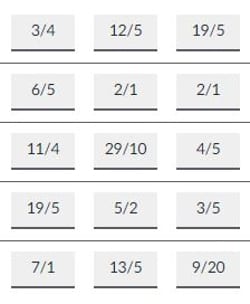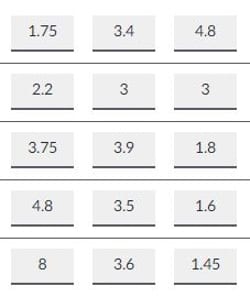 There are 3 common types of betting odds within the betting industry; fractional, decimal and American, each with their own degrees of simplicity and levels of popularity. This article will be going through the 3 types and examining how they work in an attempt for you to understand them better.
There are 3 common types of betting odds within the betting industry; fractional, decimal and American, each with their own degrees of simplicity and levels of popularity. This article will be going through the 3 types and examining how they work in an attempt for you to understand them better.
Hopefully this will help you decide which format you find easier to work with but bear in mind that not all bookies offer American as an option, whereas almost every bookie will offer the choice of either fractional or decimal.
Fractional
 Fractional odds are probably the most common of the three and also the oldest. Rather unsurprisingly, the odds are shown as a fraction, which you might remember from maths lessons in secondary school; they look like this: 2/1, 5/2, 11/8, and so on. The rule of thumb with these types of bets is that the left column highlights how much you will win if you wagered the number in the right column. So, if the bet was 5/1, then for every 1 unit that you wager, you will receive 5 units in return if that bet is successful. Another way of saying this is if you bet one you will get five back.
Fractional odds are probably the most common of the three and also the oldest. Rather unsurprisingly, the odds are shown as a fraction, which you might remember from maths lessons in secondary school; they look like this: 2/1, 5/2, 11/8, and so on. The rule of thumb with these types of bets is that the left column highlights how much you will win if you wagered the number in the right column. So, if the bet was 5/1, then for every 1 unit that you wager, you will receive 5 units in return if that bet is successful. Another way of saying this is if you bet one you will get five back.
It’s worth noting at this point that fractional bets will include your stake on top of the odds shown, meaning that the fraction actually only highlights your total net win and not your total return. It’s also worth noting that should the odds not be a fraction of 1, such as 11/8, it doesn’t mean that you have to bet 8 units on that bet, it merely means that your stake will be split into 8 units and the return worked out accordingly.
Let’s run through a few quick examples:
- You place a 10 unit bet (let’s say £10 for ease) at odds of 8/1 and your bet wins. To work out your winnings simply replace your stake in the right-hand column and multiply it by the odds in the left-hand column. In this case it would be 8 (odds) times 10 (stake), equalling 80 units (£80) in total. You will also receive your 10 unit (£10) stake back, which is not included in the odds shown, so your total return will be £80 net win plus £10 stake equalling £90.
- You place the same £10 bet at odds of 11/8. First, your stake is divided by the number on the right, so 10 (£10) divided by 8 equals 1.25 (£1.25). Your £10 bet is now split into 8 equal units. Next you need to multiply a single unit by the number on the right, so 1.25 (£1.25) times 11 (odds) equals 13.75 (£13.75). You have now found your net win. Once again, you will get your initial stake back on top so £10 stake plus £13.75 net win equals a total return of £23.75.
Get it? Got it? Good.
Decimal
 The decimal odds structure is more widely used by European bettors and is written as a decimal, which you may also remember from school and looks like this: 2.50, 4.75 or 8.00, for example. This method is very simple in that you just multiply your stake by the decimal number. It differs from the fractional odds in that the overall winnings will include your stake in the equation, making it easier to understand.
The decimal odds structure is more widely used by European bettors and is written as a decimal, which you may also remember from school and looks like this: 2.50, 4.75 or 8.00, for example. This method is very simple in that you just multiply your stake by the decimal number. It differs from the fractional odds in that the overall winnings will include your stake in the equation, making it easier to understand.
We only really need a single example for this one:
- You place at 10 unit bet (£10) at odds of 3.25. To work out the winnings for a successful bet at these odds simply multiply your 10 units by the odds of 3.25. This results in a return of 32.50 units (£32.50). The total net win would actually only be £22.50 as the decimal format includes your 10 unit (£10) stake as we already explained.
Decimal odds are becoming more and more popular because they make the job easier, and many UK facing bookies use them as default even though fractional odds are more traditional. The horses is one area where the client base is less willing to adopt decimal odds.
American
 The American style formula is made up of a positive and negative number and is very different than the two odds variations mentioned above. It’s quite a simple concept to grasp once you know how, but it requires you to think in a different way. The main thing to consider is that the negative number will be the amount you must wager to make 100 units of a net win and the positive number is the net win you will make from a 100 unit bet. It helps to bet in round numbers as you will be able to work out the equation faster.
The American style formula is made up of a positive and negative number and is very different than the two odds variations mentioned above. It’s quite a simple concept to grasp once you know how, but it requires you to think in a different way. The main thing to consider is that the negative number will be the amount you must wager to make 100 units of a net win and the positive number is the net win you will make from a 100 unit bet. It helps to bet in round numbers as you will be able to work out the equation faster.
Here are another couple of examples:
- Let’s say you make a 100 unit bet (£10, so 1 unit equals 10p) at odds of +300 on the American line. That bet wins. As the odds number is positive you will receive 300 units as your net win, plus your stake back on top. So, 300 (odds) times 10p (single unit) equals £30 net win, plus your stake of 100 units (£10) equals £40 total return.
- Let’s now say that you place the same 100 units (£10) at odds of -300 and that bet also wins. We now need to divide our stake by 300 to work out what a single unit is, so £10.00 divided by 300 is 0.033p. Given that we need to bet 300 units to get 100 units of net win, we are then able to work out that our return would be 100 times 0.033 which equals 3.33 units of net win (or £3.33), plus our 100 unit stake back. So £3.33 net win plus £10 stake equals £13.33 total return.